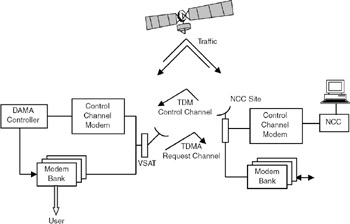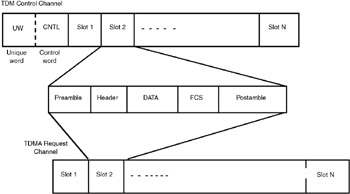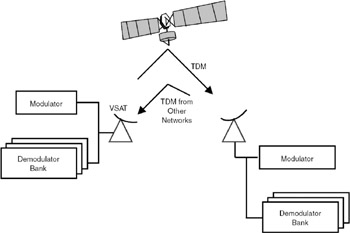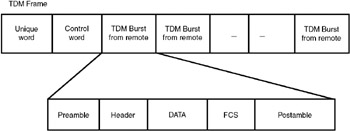13.4 MULTIPLE ACCESS TECHNIQUES
|
| < Day Day Up > |
|
13.4 MULTIPLE ACCESS TECHNIQUES
A number of multiple access techniques are used in satellite communication. Based on the type of application and the cost of the equipment, a particular multiple access technique has to be chosen. A VSAT network operating in the star configuration can use the TDM/TDMA access scheme. The central station will multiplex the data of all the remotes and broadcast it. All the remotes will receive the data, and the remote for which the data is meant will decode the data; the rest of the remotes will ignore the data. Each remote will transmit in TDMA mode in the time slot allocated to it. A signaling slot is available to each of the remotes for making a request for a TDMA traffic slot. This mechanism is useful if the network has a large number of remotes and traffic flow is mostly from the central station to the remotes. If direct communication from one remote to another remote is required, the multiple access techniques discussed in the following sections are used.
VSAT networks operating in star architecture use the TDM/TDMA access mechanism. The hub multiplexes the data of all remotes and broadcasts it. The remote stations use the TDMA slots to send their data.
13.4.1 DAMA-SCPC
In demand assigned multiple access–single channel per carrier (DAMA-SCPC), a channel is assigned to a remote only when the remote has data to transmit. The channel assignment is done by one station that acts as the network control center (NCC). Once the channel is assigned, the remote can directly transmit data to another remote (as in a mesh configuration). Because the channel is assigned based on demand, the access mechanism is DAMA. Because the data corresponding to one channel (say, voice) can be transmitted on one carrier assigned to the remote, the transmission mechanism is SCPC. SCPC got its name due to the earlier analog systems that used one channel per carrier. Now, it is possible to multiplex different channels and send the data on one carrier, which is known as multi-channel per carrier (MCPC).
The configuration of the DAMA-SCPC network is shown in Figure 13.2. At both the NCC and the remote, there will be a control channel modem and a number of modems (modem bank) to modulate and demodulate many carriers. When a remote has to communicate with another remote, it will send a request in a TDMA request channel. The NCC will send the control information to both the remotes, indicating the carrier assigned to each remote using TDM broadcast mode. The control channel modem is used exclusively for requests and commands. Once a carrier is assigned to the remote, the modem corresponding to that carrier is used to transmit the data.

Figure 13.2: DAMA-SCPC mesh architecture.
| Note | In DAMA-SCPC-based networks, each remote should have a control channel modem and a modem bank for different carrier frequencies. |
The TDM control frame and TDMA request frame formats are shown in Figure 13.3. The TDM control frame consists of unique word (UW) and control fields that are used for framing, synchronization, and timing. These fields are followed by a number of data slots, each slot for one remote. The data slot consists of:
-
Preamble to indicate the beginning of the slot
-
Header that contains the remote address and configuration information.
-
Data indicating the information for call setup and disconnection (carrier assigned).
-
Frame check sequence (FCS) containing the checksum.
-
Postamble to indicate the end of the slot.

Figure 13.3: DAMA-SCPC control and request channels.
In a satellite network using DAMA-SCPC, a remote sends a request to the network control center (NCC), and the NCC will assign different carriers to the two remotes that need to communicate with each other.
The TDMA request channel contains a series of slots for each remote. A remote has to send its requests for call setup using its slot. The slot structure is the same as the structure of the data slot in the TDM frame.
The TDM control frame consists of a unique word, control word, and a number of time slots. Each slot consists of the following fields: preamble, header, data, frame check sequence, and postamble. The TDMA request channel has the same format as the slot of the TDM control frame.
The procedure for call setup is as follows:
-
The remote sends a request in its slot of the TDMA request channel indicating the address of the called remote. The control channel modem is used for sending the request.
-
The network control center sends the control information in the TDM slot assigned to the remote indicating the carrier assigned. The control channel modem is used for sending the command.
-
Using the modem for the assigned carrier, the remote sends its data to the other remote. It needs to be noted that the data sent by a remote goes to the satellite, and the satellite broadcasts the data so that the other remotes can receive the data.
-
Once the data transfer is complete, the remote sends the request for disconnection in the TDMA request channel.
-
The network control center sends the command to the remote to free the modem corresponding to the carrier assigned earlier.
-
The carrier assigned to the remote is now available in the pool of carriers that can be assigned to the other remotes based on demand.
This configuration is very useful if remotes need to communicate with each other directly. However, one of the remotes has to act as a network control center.
13.4.2 TDM-SCPC
In time division multiplex–single channel per carrier (TDM-SCPC), every remote broadcasts its data in TDM mode. Each remote is assigned a carrier frequency permanently, and so each remote will have one modulator. However, each remote will have a bank of demodulators to demodulate the data received from other remotes. Every remote will listen to transmissions from other remotes and decode the data meant for it based on the address.
The attractive feature of this configuration is that there is no need for a network control center. Also, there is no need for call setup.

Figure 13.4: TDM-SCPC mesh architecture.
The TDM frame format is shown in Figure 13.5. The format of each slot is the same as that discussed in the previous section.

Figure 13.5: TDM-SCPC frame.
In TDM-SCPC, each remote is assigned a carrier frequency permanently, and the remote sends its data in TDM mode using broadcasting. Every remote listens to the broadcast data and decodes the data meant for it.
| Note | In TDM-SCPC-based networks, each remote will have one modulator to transmit using the carrier frequency assigned to it and also a bank of demodulators to demodulate the signals received from different remote stations. |
13.4.3 TDMA
In TDMA, all the remotes use the same frequency for transmission. As shown in Figure 13.6, at each remote there will be a burst modem. Each remote will transmit its data as a burst in the TDMA time slot assigned to it. The time slot allocation is done by the network control center.

Figure 13.6: TDMA mesh architecture.
The TDMA frame format is shown in Figure 13.7. Each time slot will have the same format as discussed earlier. Signaling from the NCC is sent in the control word. The remote obtains information about the slot allocation by analyzing the control field. Signaling from the remotes is sent in the header field. The NCC may also allocate a time slot to a free remote so that the remote can send its signaling information in the data portion of its slot.

Figure 13.7: TDMA frame format.
In TDMA-based networks, all remotes use the same frequency for transmission. Each remote will be assigned a time slot by the network control center. Using a burst modem, the remote sends its data in the time slot assigned to it.
All the access techniques we have mentioned are used in commercial systems. Because the hardware requirements vary for each type of access technique, the total system cost also varies. Based on cost considerations, a particular type of access mechanism is chosen.
|
| < Day Day Up > |
|
EAN: 2147483647
Pages: 313